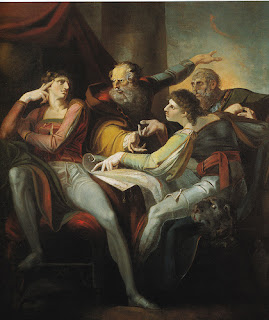H. Fuseli. The Dispute between Hotspur, Glendower, Mortimer and Worcester (Henry IV) - 1784
¨By 1830 all the Waverley novels had been worked up into plays that made money for their authors too, and for actors and theater managers. Historical settings and trappings had been part of the original charm of the novels themselves, but it was good box office to offer them in three dimensions and living color to the eager public. The stage itself became a living illustration.
Henry Fuseli. Lady Macbeth seizing the dagger
H. Fuseli. Lady Macbeth
Shakespeare´s plays were already being intensively revived, but dress for these was a trumped-up and only haphazardly historical matter. Artists were doing much better with visualizing Shakespearean clothes than actors were in dressing themselves. Costume designers were still lacking in England, though scene painting was in the hands of experts. Fuseli, that great illustrator of Shakespeare, was in Rome in the 1770´s, when most Shakespearean heroines were stalking about the London stage in huge hoops, heroes were in breeches and powder, and all were in obvious need of his superior eye. The skirts might be draped to seem Classical, and the men´s powdered wigs might be worn with a lace ¨Vandyke¨ collar; but Fuseli, in those same years, was painting dramatic scenes from Shakespeare as he thought Michelangelo might have done them -even though he was obsessed with exaggerating the latest erotic mode in dress.
So far, theatrical taste was not keeping up. But by 1794, when Kemble staged Macbeth, he was a good deal nearer the mark: ¨The witches no longer wore mittens, plaited caps, red stomachers, ruffs, etc.... or any human garb, but appeared as preternatural beings, distingsuishable only by the fellness of their purpose and the fatality of their delusions.¨ Writhing snakes and black and gray spirits are mentioned in the caldron scene; it all sounds like a description of Fuseli´s Macbeth illustrations: ¨the attempt was to strike the eye with a picture of supernatural power, by such appropriate vestures as marked neither mortal grandeur nor earthly insignificance.¨
H. Fuseli. Macbeth and the witches
Henry Fuseli. Three witches
Excerpt from Seeing Through Clothes. By Anne Hollander. Pages 288/9. USA, 1980





No comments:
Post a Comment